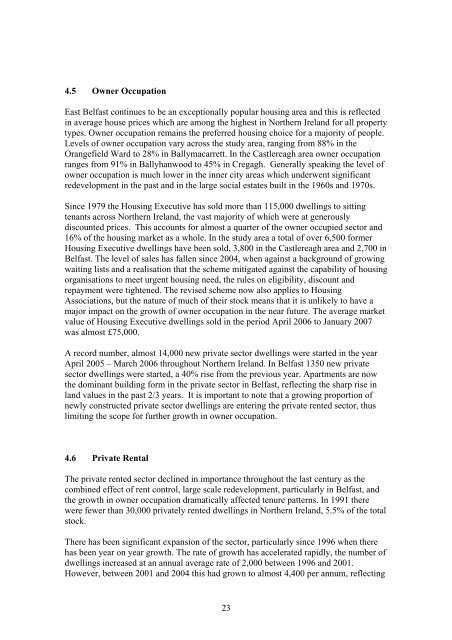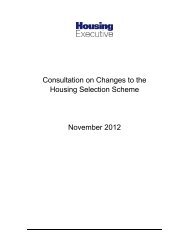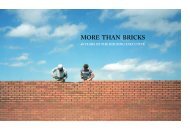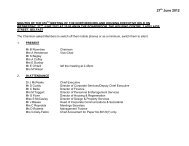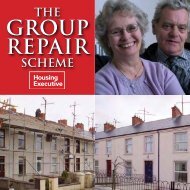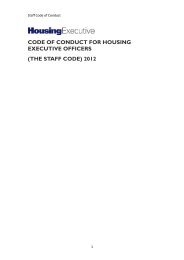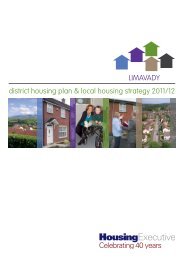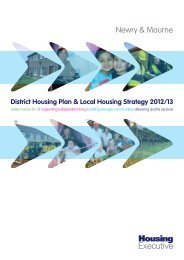East Belfast Sectoral Study - Northern Ireland Housing Executive
East Belfast Sectoral Study - Northern Ireland Housing Executive
East Belfast Sectoral Study - Northern Ireland Housing Executive
Create successful ePaper yourself
Turn your PDF publications into a flip-book with our unique Google optimized e-Paper software.
4.5 Owner Occupation<br />
<strong>East</strong> <strong>Belfast</strong> continues to be an exceptionally popular housing area and this is reflected<br />
in average house prices which are among the highest in <strong>Northern</strong> <strong>Ireland</strong> for all property<br />
types. Owner occupation remains the preferred housing choice for a majority of people.<br />
Levels of owner occupation vary across the study area, ranging from 88% in the<br />
Orangefield Ward to 28% in Ballymacarrett. In the Castlereagh area owner occupation<br />
ranges from 91% in Ballyhanwood to 45% in Cregagh. Generally speaking the level of<br />
owner occupation is much lower in the inner city areas which underwent significant<br />
redevelopment in the past and in the large social estates built in the 1960s and 1970s.<br />
Since 1979 the <strong>Housing</strong> <strong>Executive</strong> has sold more than 115,000 dwellings to sitting<br />
tenants across <strong>Northern</strong> <strong>Ireland</strong>, the vast majority of which were at generously<br />
discounted prices. This accounts for almost a quarter of the owner occupied sector and<br />
16% of the housing market as a whole. In the study area a total of over 6,500 former<br />
<strong>Housing</strong> <strong>Executive</strong> dwellings have been sold, 3,800 in the Castlereagh area and 2,700 in<br />
<strong>Belfast</strong>. The level of sales has fallen since 2004, when against a background of growing<br />
waiting lists and a realisation that the scheme mitigated against the capability of housing<br />
organisations to meet urgent housing need, the rules on eligibility, discount and<br />
repayment were tightened. The revised scheme now also applies to <strong>Housing</strong><br />
Associations, but the nature of much of their stock means that it is unlikely to have a<br />
major impact on the growth of owner occupation in the near future. The average market<br />
value of <strong>Housing</strong> <strong>Executive</strong> dwellings sold in the period April 2006 to January 2007<br />
was almost £75,000.<br />
A record number, almost 14,000 new private sector dwellings were started in the year<br />
April 2005 – March 2006 throughout <strong>Northern</strong> <strong>Ireland</strong>. In <strong>Belfast</strong> 1350 new private<br />
sector dwellings were started, a 40% rise from the previous year. Apartments are now<br />
the dominant building form in the private sector in <strong>Belfast</strong>, reflecting the sharp rise in<br />
land values in the past 2/3 years. It is important to note that a growing proportion of<br />
newly constructed private sector dwellings are entering the private rented sector, thus<br />
limiting the scope for further growth in owner occupation.<br />
4.6 Private Rental<br />
The private rented sector declined in importance throughout the last century as the<br />
combined effect of rent control, large scale redevelopment, particularly in <strong>Belfast</strong>, and<br />
the growth in owner occupation dramatically affected tenure patterns. In 1991 there<br />
were fewer than 30,000 privately rented dwellings in <strong>Northern</strong> <strong>Ireland</strong>, 5.5% of the total<br />
stock.<br />
There has been significant expansion of the sector, particularly since 1996 when there<br />
has been year on year growth. The rate of growth has accelerated rapidly, the number of<br />
dwellings increased at an annual average rate of 2,000 between 1996 and 2001.<br />
However, between 2001 and 2004 this had grown to almost 4,400 per annum, reflecting<br />
23


